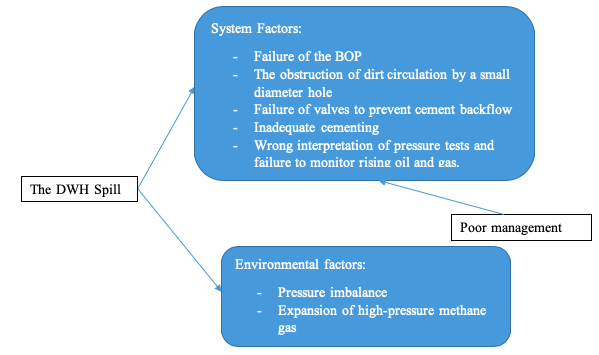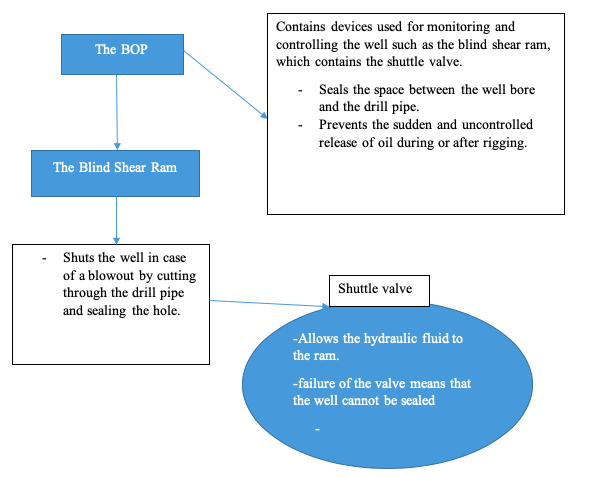Select a recent marine system failure that has attracted your interest. Collect information relating to the failure from different sources such as reports, statements, newspapers, magazines or journals. Include these sources with your answer.
A: 15% Name and draw a systems map to include all of the important components mentioned in the sources. Organise them into environmental factors, wider system factors and the system under study.
B: 15% Draw a Sequential Fact Diagram (SFD) based on the sources and the system map. Remember to include only those items for which evidence exists.
C: 20% Write a short factual report based on your SFD
Solution
Marine System Failure – A Case of the Deepwater Horizon Spill
The Deepwater Horizon (DWH) rig explosion and spill occurred on April 20, 2010, in the Gulf of Mexico. It occurred following the explosion of the semi-submersible offshore drilling rig that was dynamically positioned for the exploration of a deep oil well of 5 600 m below the sea level in approximately 1 500 m of water. The rig was commissioned by the R&B Falcon but later owned by the Transocean and leased to the British Petroleum (BP). The DWH was a fifth-generation model type RBS-8D, deep-water, column-stabilized and dynamically semi-submersible mobile offshore unit positioned dynamically for the exploration of subsea oil wells (Freudenburg & Gramling, 2011). The design uses a blowout preventer for sealing, controlling and monitoring oil and gas wells for the prevention of blowout. The failure of the blowout preventer (BOP) to fully engage by activating automatically and cutting the drill string and sealing the well among other system failures caused the oil spill. The system failure and other environmental factors caused adverse environmental and socio-economic effects following the 87 days of the oil spill and the release of more than 200 million gallons of crude oil into the Gulf of Mexico (Eargle & Esmail, 2012).

Poor management led to the development of the marine system failure of the DWH. While focusing on profit maximization, the management failed to prioritize critical issues. The proper cementing of the well, close monitoring and evaluation of valves and the BOP, and the right interpretation of pressure tests would have prevented the environmental factors such as pressure imbalance and the expansion and rise of the high-pressure methane gas into the drilling rig.


(Gröndahl, Park, Roberts, & Tse, 2010)
Factual Report
The Deepwater Horizon Spill is the largest oil spill accident in the history of the US petroleum industry. It released over 700 000 tonnes of crude oil into the marine environment of the Gulf of Mexico. The accident caused the death of eleven workers, the serious injury of 16 others. The explosion of the well, the release of high-pressure methane and spillage of oil caused fire and the contamination of a wide marine area. As such, the impact was significant on the ecosystem surrounding the area and maybe experienced for many years to come. According to Freudenburg and Gramling (2011), the major causes were directly connected to poor management by the BP and included the wrong interpretation of pressure tests, inadequate cementing, poor monitoring and evaluation of the rising oil, gas and the equipment. The failure of the BOP’s key component devices was the major cause of the spill. The blind shear ram of the BOP failed to close and prevent the cement backflow and uncontrolled release of the oil and gas into the rig.
The marine system failure led to diverse
ecological/environmental and economic effects. The biotic communities and
habitats were greatly affected by the oil spill. The release of the crude oil
into the marine environment threatened marine species in various U.S. national
parks. The area of the spill harbours numerous species that were affected by
limited oxygen and the release of different contaminants from the oil. According
to Eargle and
Esmail (2012), the ecosystem will require years or
decades to recover from the impact of the spill. As such, even when the
government allocated an enormous budget towards the management and response to
the spill, there is a need to implement measures to minimize the impact and
prevent recurrence of spills. Moreover, the spill had a huge economic impact
that affected the BP Corporation, the US, and the UK significantly. The spill
affected fisheries, tourism and the real estate industries in the US and
impacted on the then UK’s largest corporation greatly, causing numerous economic
effects. The BP suffered a liability of approximately US $100 billion and
expenditures of more than US $3.12 billion in response, containment, claims and
federal costs among others (US National Commission on the BP Deepwater
Horizon Oil Spill and Offshore Drilling, 2011). Moreover, it caused
a strain in the economic relations and operations of UK corporations in the US.
References
BBC. (2011, January 6). US oil spill: ‘Bad management’ led to BP disaster. Retrieved from BBC News: http://www.bbc.com/news/world-us-canada-12124830
Eargle, L. A., & Esmail, A. (2012). Black beaches and bayous: the BP Deepwater Horizon oil spill disaster. Lanham: University Press of America.
Freudenburg, W. R., & Gramling, R. (2011). Blowout in the Gulf: the BP oil spill disaster and the future of energy in America. Cambridge: MIT Press.
Gröndahl, M., Park, H., Roberts, G., & Tse, A. (2010). Investigating the Cause of the Deepwater Horizon Blowout. Retrieved from The New York Times: http://www.nytimes.com/interactive/2010/06/21/us/20100621-bop.html?_r=0
US National Commission on the BP Deepwater Horizon Oil Spill and Offshore Drilling. (2011). Deepwater : the Gulf oil disaster and the future of offshore drilling: report to the President. Washington, DC: National Commission on the BP Deepwater Horizon Oil Spill and Offshore Drilling.

